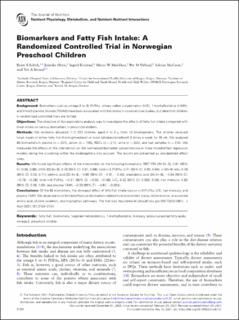| dc.description.abstract | Background: Biomarkers such as omega-3 (n-3) PUFAs, urinary iodine concentration (UIC), 1-methylhistidine (1-MH), and trimethylamine N-oxide (TMAO) have been associated with fish intake in observational studies, but data from children in randomized controlled trials are limited. Objectives: The objective of this exploratory analysis was to investigate the effects of fatty fish intake compared with meat intake on various biomarkers in preschool children. Methods: We randomly allocated (1:1) 232 children, aged 4 to 6 y, from 13 kindergartens. The children received lunch meals of either fatty fish (herring/mackerel) or meat (chicken/lamb/beef) 3 times a week for 16 wk. We analyzed 86 biomarkers in plasma (n = 207), serum (n = 195), RBCs (n = 211), urine (n = 200), and hair samples (n = 210). We measured the effects of the intervention on the normalized biomarker concentrations in linear mixed-effect regression models taking the clustering within the kindergartens into account. The results are presented as standardized effect sizes. Results: We found significant effects of the intervention on the following biomarkers: RBC EPA (20:5n-3), 0.61 (95% CI: 0.36, 0.86); DHA (22:6n-3), 0.43 (95% CI: 0.21, 0.66); total n-3 PUFAs, 0.41 (95% CI: 0.20, 0.64); n-3/n-6 ratio, 0.48 (95% CI: 0.24, 0.71); adrenic acid (22:4n-6, -0.65 (95% CI: -0.91, -0.40), arachidonic acid (20:4n-6), -0.54 (95% CI: -0.79, -0.28); total n-6 PUFAs, -0.31 (95% CI: -0.56, -0.06); UIC, 0.32 (95% CI: 0.052, 0.59); hair mercury, 0.83 (95% CI: 0.05, 1.05); and plasma 1-MH, -0.35 (95% CI: -0.61, -0.094). Conclusions: Of the 86 biomarkers, the strongest effect of fatty fish intake was on n-3 PUFAs, UIC, hair mercury, and plasma 1-MH. We observed no or limited effects on biomarkers related to micronutrient status, inflammation, or essential amino acid, choline oxidation, and tryptophan pathways.The trial was registered at clinicaltrials.gov (NCT02331667). Keywords: 1-methylhistidine; biomarkers; fatty fish; mercury; omega-3; polyunsaturated fatty acids; preschool children; targeted metabolomics. © The Author(s) 2021. Published by Oxford University Press on behalf of the American Society for Nutrition. | |

